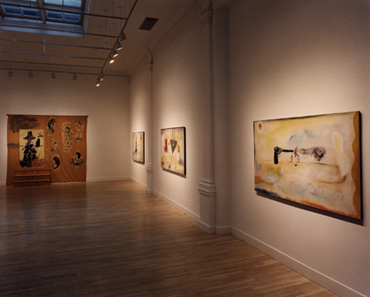
LA-BAS
Many years ago, while traveling by traveling through the American Southwest and the varying countryside’s of Northern and Central Mexico, I found myself jotting down notes alternately on the subjects of Michael Byron’s art and Malcolm Lowry’s Under the Volcano. At the time, the two struck me as ideal complements- in a sense, a perfect interdisciplinary fit- for they touched upon m much of the same subject matter and seemed to share a fascination for similar landscapes, time-frames, and states of mind: each depicted a seemingly weightless universe in which temporal situations were either dramatically foreshortened or denied, a strangely metaphoric realm in which aridness and humidity mingled, in which heightened emotion and intense reserve were combined; each made subtle u e of emblematic icons and mythic signs whether in the shape of puppets, fetishes, tattoos, totemic figurines, or votive charms- in order to allude to or to introduce a more literal sense of mysticism into their already symbolically-charged art. Thinking of one while reading the other, I noted their shared concern for the tragic aspects f human theater, for the dislocating and dislocated states of intoxication and delirium, for the carnivalesque atmosphere of religious pageants-The Day of the Dead in p particularly where the supernatural and the everyday are intertwined. Both Lowry and Byron seemed to feel at home in this dizzying netherworld, and both were quite adept at bringing their audiences- whether viewer or reader-dangerously close to the lip of the abyss, to the whirlpool’s swirling eye.
In those days, Byron’s art was quite specific in its references to location; his metaphoric nether-zones were most often situated in places that we have come to associate with “the edge of the known:” in remote Spanish colonial outposts where Catholicism is more Pagan than Christian; in towns on the fringe of jungles or deserts; in bordertown cantinas and underworld barscrossroads where divergent natures and cultures intersect, where passion is visible in every bead of sweat, where brutality has been ritualized and is spoken of as if it were simply stylized desire- a disconcerting universe of mysterious and unexpected shifts, a world forever on the verge of chaos, always about to erupt into frenzy or, just as easily, to burst into song.
In every region on the globe such human theater unfolds, and over the recent years, Byron has expanded his vocabulary, his repertoire, in order to represent the many manifestations and variations on these universal themes. No longer situated only in the American Southwest, his art now celebrates those bonds which transcend temporal and national boundaries. Any culture that has given allegorical form to concepts as basic yet enigmatic as Love or Death, any people who have attempted to name the sacred mysteries and those nameless mystical states, anywhere that men and women have been known to sing or dance … all have been embraced in a manner that is less cross-cultural than pantheistic. India is now referred to, its costumes and sacred symbols appearing here and there on Byron’s stage. His references now link China to Germany and Germany, in turn, to Spain, so that Faust appears both as a fandango dancer and as bearded Oriental sage, each character questioning the nature of the world as we know it, each probing its boundaries and peering off its edge.
Crossing the threshold into Byron’s world is not unlike the act of immersing yourself in a bath, for it is essentially a passive act requiring you to set your mind adrift and to lose yourself in seemingly immaterial surroundings. It depends upon a certain suspension of disbelief, as well as a willingness to enter into communion with, to surrender to another’s delirious motions. Once inside, you will sway to the rhythms of its tides; you will float freely through holes in time, as you descend slowly toward the center of the maelstrom. Vaya con Dios.




